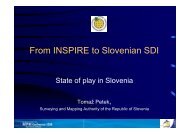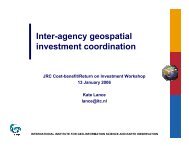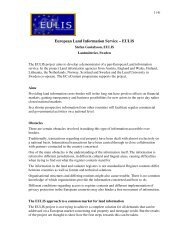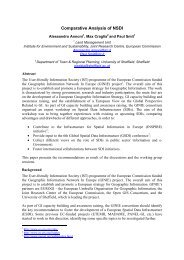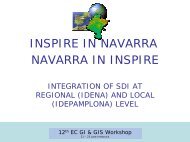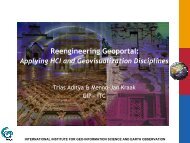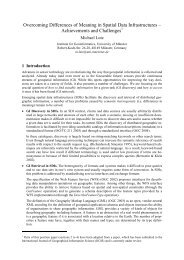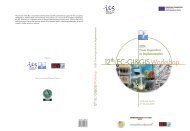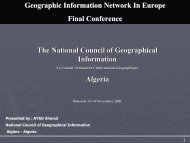II status is a crucial point for NSDI development. - EC GI & GIS Portal
II status is a crucial point for NSDI development. - EC GI & GIS Portal
II status is a crucial point for NSDI development. - EC GI & GIS Portal
Create successful ePaper yourself
Turn your PDF publications into a flip-book with our unique Google optimized e-Paper software.
<strong>GI</strong>S, SD<strong>II</strong> and <strong>II</strong><br />
position statement<br />
Jiri Horak<br />
VSB-Technical University of Ostrava, institute of<br />
geoin<strong>for</strong>matics<br />
& Czech Association <strong>for</strong> Geoin<strong>for</strong>mation
Does customer need <strong>GI</strong>S or IS?<br />
A typical enduser <strong>is</strong> not interested if he/she uses IS<br />
or <strong>GI</strong>S, or how much <strong>is</strong> the application spatial<br />
enabled.<br />
He/she expects that the designer of application takes<br />
advantages of all relevant technologies.<br />
Every developer of „spatial“ application cannot omit<br />
the IT progress.<br />
� difficult to separate the <strong>development</strong> of IT and <strong>GI</strong>T,<br />
they are coupled, and the similar can be said about <strong>II</strong><br />
and SDI.<br />
Enschede 31.3.-1.4.2005 Cross-Learning between SDI and <strong>II</strong> Jiri Horak
IT <strong>development</strong> reflecting<br />
spatial data and application<br />
Appropriate ways to store spatial data<br />
Improvement of accessibility (indexing,<br />
sorting, data querying)<br />
Appropriate design of spatial extended<br />
application<br />
� Some features are still m<strong>is</strong>sing to be reflected<br />
appropriate and sufficient way<br />
Enschede 31.3.-1.4.2005 Cross-Learning between SDI and <strong>II</strong> Jiri Horak
<strong>GI</strong>S = good consumer of <strong>for</strong>eign data<br />
<strong>GI</strong>S <strong>is</strong> highly dependent on data and uses “abnormal” portion of<br />
external data (data provided by external organ<strong>is</strong>ation, typically state<br />
organ<strong>is</strong>ation or private spatial data provider)<br />
The reason = scale. The typical <strong>GI</strong>S models a part of the landscape<br />
or country and shares a relevant part of the space with other subjects.<br />
=> no sense to develop and maintain own description of th<strong>is</strong> part of<br />
space. Morever, primary acqu<strong>is</strong>ition of spatial data requests experts<br />
and the cost <strong>is</strong> relatively high.<br />
dec<strong>is</strong>ion maker has to rely on “<strong>for</strong>eign” data – requests <strong>for</strong> data<br />
relevancy, appropriateness, content, and other aspects of data quality<br />
Issues of reusing of ex<strong>is</strong>ting data sources, process of data<br />
harmon<strong>is</strong>ation, exchange, supply<br />
We need to assure:<br />
� data exchange<br />
� Metadata (and services)<br />
� Reference (core) data<br />
� Guarantee (certification) both <strong>for</strong> data content and <strong>for</strong> services of data supply<br />
Enschede 31.3.-1.4.2005 Cross-Learning between SDI and <strong>II</strong> Jiri Horak
Selected specific features<br />
of spatial data<br />
Most of spatial data <strong>is</strong> georeferenced - they are connected and<br />
dependent on the reference system and, more, quite often to the<br />
“master” layer on which new data was created. Th<strong>is</strong> sort of<br />
dependency <strong>is</strong> not trivial, because it <strong>is</strong> not easy to replace one<br />
referencing system (or reference data) by another one.<br />
The spatial data are scale dependent. The data <strong>for</strong>mal<strong>is</strong>ation <strong>is</strong><br />
toughly connected with certain level of object recognition.<br />
Ex<strong>is</strong>tence of more than 1 representation of the modelled object in<br />
spatial data. Each representation <strong>is</strong> linked with specific request <strong>for</strong><br />
recognition, understanding and <strong>for</strong>mal<strong>is</strong>ation of the object, relevant to<br />
specific purposes. The <strong>is</strong>sue ar<strong>is</strong>es when we need to establ<strong>is</strong>h joint<br />
core data derived from a common representation of the object.<br />
Enschede 31.3.-1.4.2005 Cross-Learning between SDI and <strong>II</strong> Jiri Horak
Expected technological<br />
<strong>development</strong> in <strong>GI</strong>T - 1<br />
spatial data collection with high accuracy, high<br />
resolution, equipped with full metadata during the<br />
collection (condition of measurement, identification of<br />
measurement tool, automatic recording of location, identification<br />
of person, etc.).<br />
The movement of interest from “<strong>point</strong>” measurement<br />
and data collection to “continual” measurement and<br />
data collection.<br />
processing of vast volume of data – how to store<br />
such volumes, prepare appropriate ontology,<br />
methods of processing (e.g. interpolation, pattern<br />
recognition, automatic feature recognition and extraction);<br />
methods of evaluation and interpretation.<br />
How to manipulate with unstructured (original) data?<br />
Enschede 31.3.-1.4.2005 Cross-Learning between SDI and <strong>II</strong> Jiri Horak
Expected technological<br />
<strong>development</strong> in <strong>GI</strong>T - 2<br />
data assimilation techniques – combination of various<br />
data, which differs by source, <strong>for</strong>m, quality aspects<br />
etc.<br />
new type of sensors connected with rapid progress in<br />
nanotechnologies (e.g. smart dust) and identification<br />
techniques – how to process such volume of data,<br />
application of interpolation techniques, spatial<br />
stat<strong>is</strong>tics of results, spatial modelling, feedback to<br />
sensors or control tools etc.<br />
dealing with uncertainty. Various sources of<br />
uncertainty. Movement from “hard” (cr<strong>is</strong>p) methods to<br />
“soft” and fuzzy methods. Processing of continuous<br />
data, often with random value variation.<br />
Enschede 31.3.-1.4.2005 Cross-Learning between SDI and <strong>II</strong> Jiri Horak
Expected technological<br />
<strong>development</strong> in <strong>GI</strong>T - 3<br />
util<strong>is</strong>ation of large volume of data originated from egovernment<br />
(person, building, lot, address, company<br />
reg<strong>is</strong>ters and evidence of activities) – util<strong>is</strong>ation in broad<br />
range of application like socio-economic monitoring;<br />
<strong>is</strong>sues of data protection, data adjustment, data<br />
v<strong>is</strong>ual<strong>is</strong>ation.<br />
new methods of storing, processing and v<strong>is</strong>ual<strong>is</strong>ation<br />
of data continual in space and time (usually data are<br />
measured in some <strong>point</strong> or slices both in space and on time axe,<br />
but we need to evaluate the whole segment in space and time<br />
range)<br />
new methods in spatial analys<strong>is</strong> – e.g. advanced<br />
spatial stat<strong>is</strong>tics<br />
Enschede 31.3.-1.4.2005 Cross-Learning between SDI and <strong>II</strong> Jiri Horak
Expected technological<br />
<strong>development</strong> in <strong>GI</strong>T - 4<br />
extended application of modelling approach<br />
(numerical modelling, stochastic simulation)<br />
in various branches<br />
v<strong>is</strong>ual<strong>is</strong>ation and real<strong>is</strong>tic v<strong>is</strong>ual<strong>is</strong>ation<br />
---------------------------------------------------------------<br />
<strong>development</strong> of interoperability standards -<br />
e.g. standards <strong>for</strong> services SOA<br />
application of semantic web and ontology<br />
<strong>development</strong><br />
Enschede 31.3.-1.4.2005 Cross-Learning between SDI and <strong>II</strong> Jiri Horak
Enschede 31.3.-1.4.2005 Cross-Learning between SDI and <strong>II</strong> Jiri Horak
Common challenges<br />
The design and <strong>development</strong> of application<br />
<strong>for</strong> handicapped people.<br />
E.g. “blind friendly” applications are important <strong>for</strong><br />
not neglected part of population.<br />
find appropriate way to change “v<strong>is</strong>ual<strong>is</strong>ation” to<br />
more common “perception” (hearing, touching etc.) <strong>for</strong><br />
spatial applications (maps, spatial models)<br />
Enschede 31.3.-1.4.2005 Cross-Learning between SDI and <strong>II</strong> Jiri Horak
Progress in geographical thinking<br />
Not only <strong>development</strong> of technical aspects of <strong>GI</strong>T<br />
Development of the cognitive aspect of spatial<br />
in<strong>for</strong>mation transfer<br />
Geoin<strong>for</strong>matic literacy cons<strong>is</strong>ts of geographical,<br />
cartographical and in<strong>for</strong>matic literacy and each kind<br />
of literacy cannot be underestimated or omitted.<br />
If cartographical literacy <strong>is</strong> neglected the scientific results are<br />
not presented or transferred appropriate way and it can<br />
easily lead to m<strong>is</strong>interpretation of these results.<br />
Enschede 31.3.-1.4.2005 Cross-Learning between SDI and <strong>II</strong> Jiri Horak
Final goals of INSPIRE:<br />
SDI<br />
• The Implementing Rule on metadata – description of<br />
the content and structure of the metadata <strong>for</strong> spatial<br />
data. Two kinds of metadata - metadata <strong>for</strong> spatial<br />
services and metadata <strong>for</strong> spatial data.<br />
Rules; multilingual <strong>is</strong>sues; certification, quality, accuracy,<br />
thesauri; standards.<br />
• Implementing Rule <strong>for</strong> harmon<strong>is</strong>ed data<br />
specifications and exchange (definition of basic<br />
conceptual model, guidelines, general<strong>is</strong>ation rules, encoding)<br />
• Implementing Rule on network services<br />
• Implementing Rules on data and service sharing<br />
Enschede 31.3.-1.4.2005 Cross-Learning between SDI and <strong>II</strong> Jiri Horak
<strong>NSDI</strong> - National Geoin<strong>for</strong>mation<br />
Infrastructure - Czech republic<br />
prepared by CA<strong>GI</strong> (Czech Association <strong>for</strong><br />
Geoin<strong>for</strong>mation) and NEMOFORUM (2001)<br />
approved by the Adv<strong>is</strong>ory board of the government<br />
<strong>for</strong> in<strong>for</strong>mation policy<br />
The main goal <strong>is</strong> to assure and to facilitate <strong>for</strong> the<br />
most broad set of users the access to wide range of<br />
geoin<strong>for</strong>mation in user friendly <strong>for</strong>m and with full<br />
util<strong>is</strong>ation of up-to-date (geo)in<strong>for</strong>mation and<br />
communication technologies.<br />
Enschede 31.3.-1.4.2005 Cross-Learning between SDI and <strong>II</strong> Jiri Horak
<strong>NSDI</strong> requests<br />
the ex<strong>is</strong>tence of the Programme of NG<strong>II</strong> <strong>development</strong> and its<br />
acceptation by public admin<strong>is</strong>tration and self-government bodies<br />
<strong>development</strong> and shaping of NG<strong>II</strong> in relation to ex<strong>is</strong>ting Pan-European<br />
and World initiative<br />
coordination and cooperation of stakeholders in geomatic and<br />
geoin<strong>for</strong>matic fields<br />
technical conditions <strong>for</strong> processing and accessibility of geodata and<br />
geoin<strong>for</strong>mation<br />
organ<strong>is</strong>ational, leg<strong>is</strong>lative, financial and other conditions <strong>for</strong><br />
accessibility of geodata and geoin<strong>for</strong>mation<br />
basic data funds (data bases) of geodata<br />
in<strong>for</strong>mation support <strong>for</strong> available geodata data funds, its sources and<br />
conditions of availability<br />
standard exchange <strong>for</strong>mat <strong>for</strong> geodata (and files), standard description<br />
of data funds, terminology in geomatics and geoin<strong>for</strong>matics branches<br />
qualification of experts in geomatics and geoin<strong>for</strong>matics branches<br />
knowledge level of user which enables to use new possibilities and<br />
availability of geodata and geoin<strong>for</strong>mation<br />
Enschede 31.3.-1.4.2005 Cross-Learning between SDI and <strong>II</strong> Jiri Horak
CA<strong>GI</strong> contribution in education<br />
a periodic review of educational activities aiming to<br />
<strong>GI</strong>&<strong>GI</strong>T.<br />
a competition „Geoaplikace“ (Geo-application) since<br />
1999 to improve a geoin<strong>for</strong>matic literacy<br />
other educational activities targeted to officers of<br />
public sector – training courses:<br />
� Introduction to <strong>GI</strong>S/<strong>GI</strong>T,<br />
� metadata,<br />
� spatial analys<strong>is</strong> <strong>for</strong> labour market, etc.<br />
Enschede 31.3.-1.4.2005 Cross-Learning between SDI and <strong>II</strong> Jiri Horak
Appropriate framework of <strong>NSDI</strong> … <strong>II</strong><br />
Main aspects to be solved (but not only):<br />
definition and acceptation of leg<strong>is</strong>lative norms – the<br />
protection of private data, free access to in<strong>for</strong>mation, the<br />
protection of secret in<strong>for</strong>mation, electronic signature, authors<br />
rights, acting of in<strong>for</strong>mation system of public admin<strong>is</strong>tration<br />
wide accessibility of in<strong>for</strong>mation and communication<br />
technologies, including geoin<strong>for</strong>mation technologies<br />
<strong>II</strong> <strong>status</strong> <strong>is</strong> a <strong>crucial</strong> <strong>point</strong> <strong>for</strong> <strong>NSDI</strong> <strong>development</strong>.<br />
If <strong>II</strong> <strong>is</strong> weakly prepared and developed, the <strong>NSDI</strong><br />
<strong>development</strong> cannot standalone solve common<br />
<strong>is</strong>sues and still fight with basic obstacles and barriers<br />
that are not eliminated by the appropriate <strong>II</strong><br />
<strong>development</strong>.<br />
Enschede 31.3.-1.4.2005 Cross-Learning between SDI and <strong>II</strong> Jiri Horak
Remarks to Czech <strong>II</strong> <strong>development</strong><br />
New document “State in<strong>for</strong>mation and communication<br />
policy – e-Cesko 2006” (Czech government according to<br />
e-Europe+) in negotiation process:<br />
Available communication services<br />
In<strong>for</strong>matic literacy (reach the one half of citizens with basic<br />
computer skill)<br />
Public services on-line<br />
Environment suitable <strong>for</strong> e-business<br />
Main access <strong>point</strong> <strong>for</strong> e-government - <strong>Portal</strong> of public<br />
admin<strong>is</strong>tration (central access to in<strong>for</strong>mation and eservices)<br />
Example of spatial e-service - d<strong>is</strong>tant access to Cadastral<br />
Reg<strong>is</strong>ter (Czech Surveying and Cadastral Office)<br />
Enschede 31.3.-1.4.2005 Cross-Learning between SDI and <strong>II</strong> Jiri Horak
Thank you <strong>for</strong> your attention.<br />
jiri.horak@vsb.cz<br />
Thanks to JRC and ITC Enschede<br />
Thanks to Eva Pauknerova (JRC), Petr Kubicek (Intergraph<br />
CZ), Vit Vozenilek (Palacky University of Olomouc), Petr<br />
Rapant, Bron<strong>is</strong>lava Horakova (VSB-TU Ostrava)<br />
Enschede 31.3.-1.4.2005 Cross-Learning between SDI and <strong>II</strong> Jiri Horak




